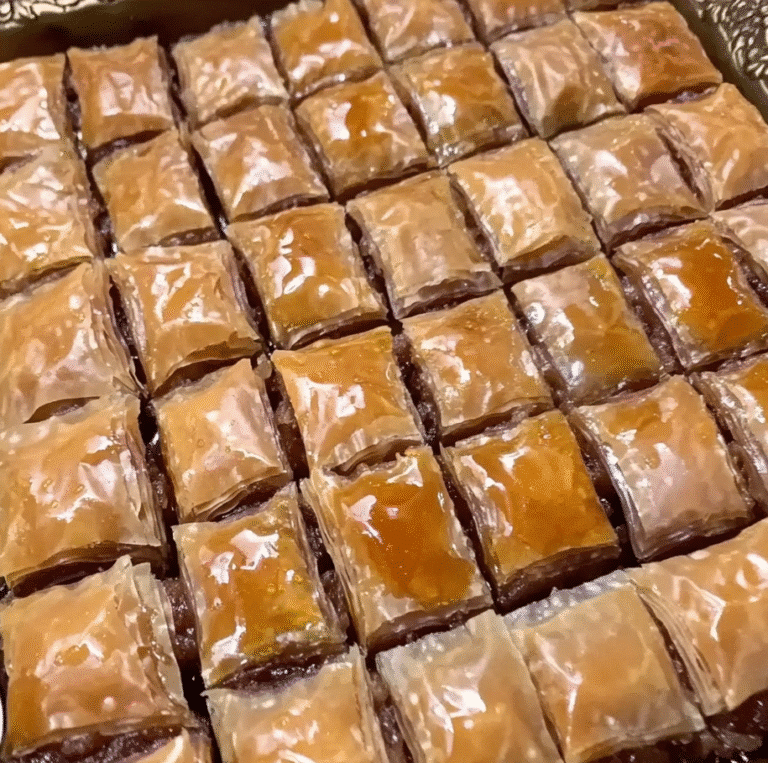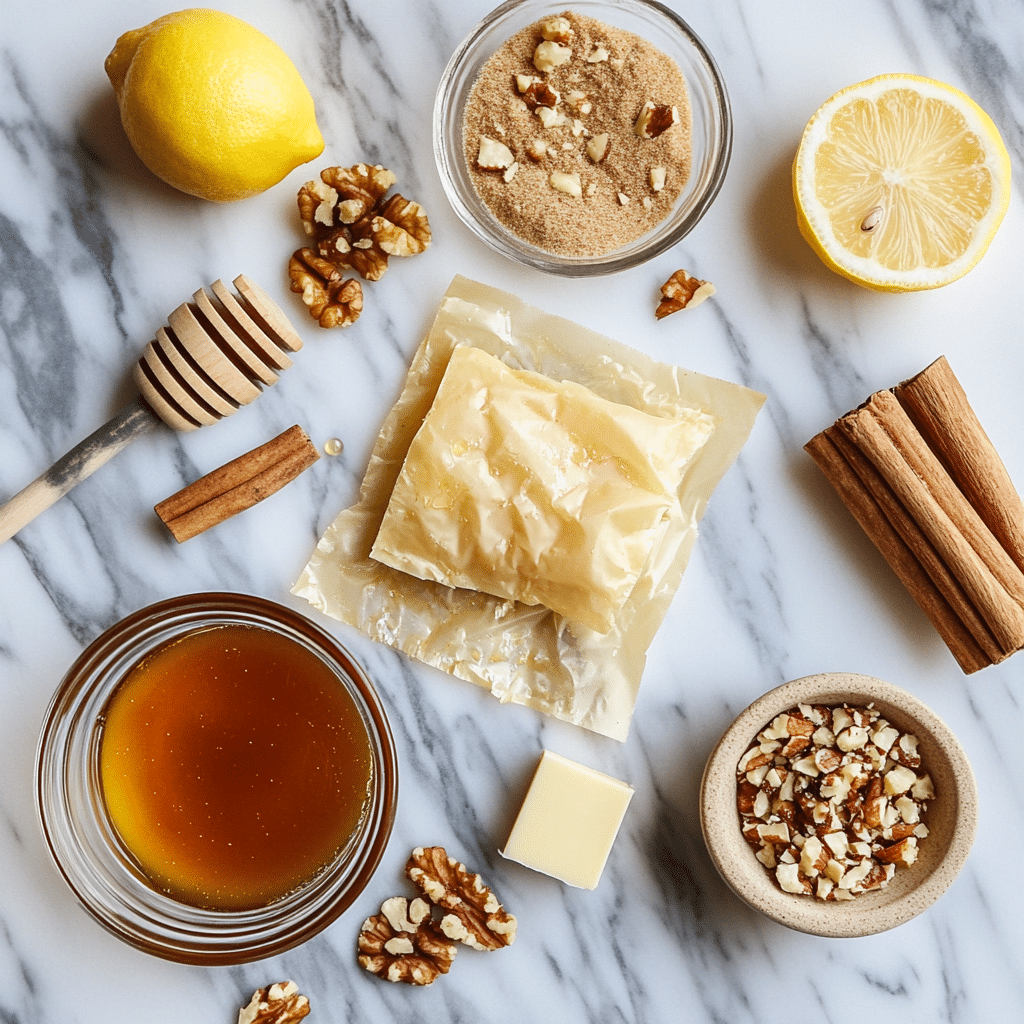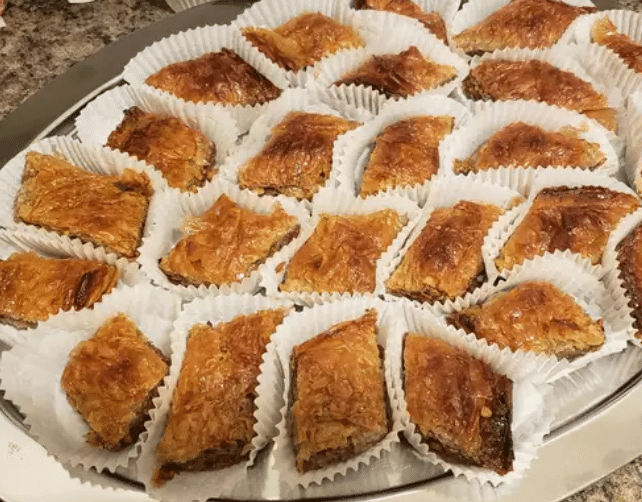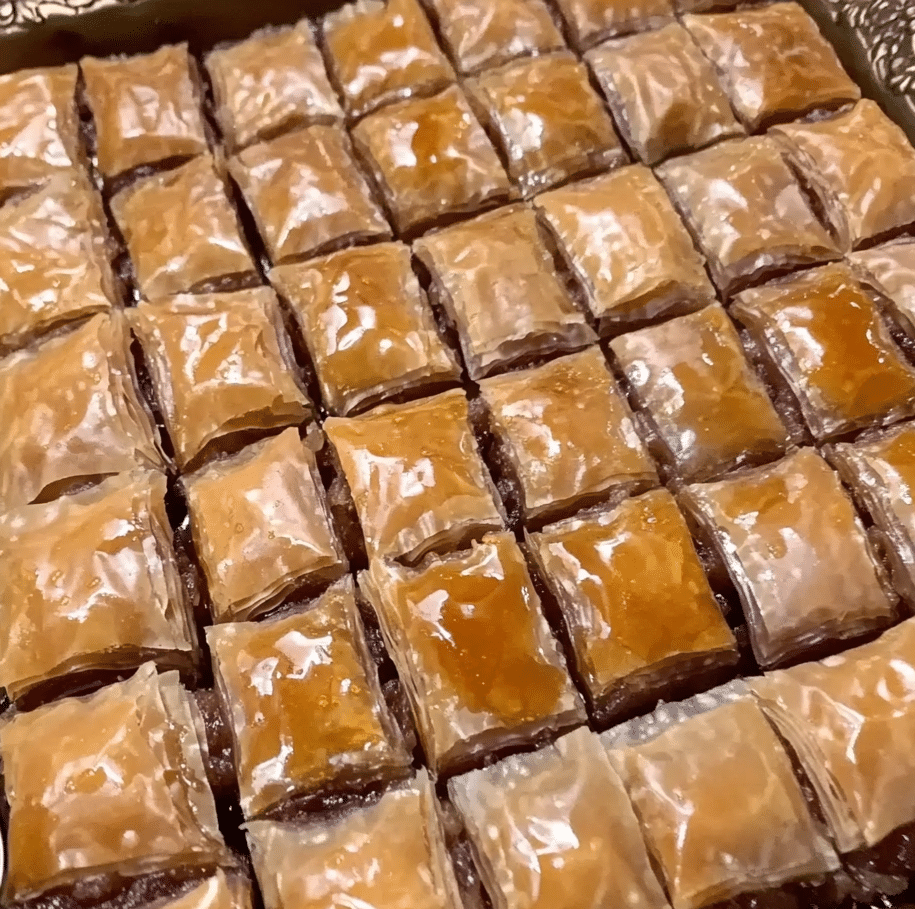There’s something hypnotic about the scent of buttered phyllo and spiced nuts drifting through a warm kitchen. For me, baklava isn’t just dessert—it’s a story. I still remember helping my grandmother in her Asheville kitchen, brushing delicate layers of dough with melted butter and sneaking spoonfuls of sticky syrup when she wasn’t looking. That early memory sparked a lifelong love for food, and today I’m sharing the baklava recipe that means the most to me. Whether you’re a seasoned cook or this is your first try, this is one dessert you’ll want to make again and again.
Print
Baklava Recipe – Sweet, Flaky Layers with Honey & Nuts
A flaky, nutty, and syrup-soaked dessert, this baklava recipe blends phyllo pastry, walnuts, pistachios, and warm spices into a timeless treat.
- Total Time: 1 hour 20 minutes
- Yield: 24 pieces 1x
Ingredients
1 lb phyllo dough, thawed
1 cup unsalted butter, melted
2½ cups chopped walnuts and pistachios
1 tsp ground cinnamon
1 cup granulated sugar
½ cup honey
¾ cup water
1 tbsp lemon juice
Instructions
1. Preheat oven to 350°F (175°C).
2. Butter a 9×13 inch baking dish and layer 10 sheets of phyllo, brushing each with melted butter.
3. Spread a layer of the nut mixture (nuts + cinnamon) evenly.
4. Add 5 more phyllo sheets, buttering each, and another layer of nuts. Repeat until all nuts are used.
5. Top with remaining phyllo sheets, buttering each one.
6. Using a sharp knife, cut into diamonds or squares.
7. Bake for 45–50 minutes until golden and crisp.
8. Meanwhile, prepare syrup by simmering water, sugar, honey, and lemon juice for 10 minutes.
9. Pour cooled syrup evenly over hot baklava.
10. Let cool for several hours before serving.
Notes
Store baklava at room temperature for 3–5 days.
Use a damp towel over phyllo to prevent drying while working.
Customize nut blend to taste (almonds, hazelnuts, etc.).
- Prep Time: 30 minutes
- Cook Time: 50 minutes
- Category: Dessert
- Method: Baking
- Cuisine: Middle Eastern
- Diet: Vegetarian
Nutrition
- Serving Size: 1 piece
- Calories: 250
- Sugar: 18g
- Sodium: 45mg
- Fat: 16g
- Saturated Fat: 7g
- Unsaturated Fat: 8g
- Trans Fat: 0g
- Carbohydrates: 28g
- Fiber: 2g
- Protein: 3g
- Cholesterol: 20mg
The Heart of the Baklava Recipe
Why this baklava recipe means so much
Every time I make baklava, it takes me back to the first time I felt magic in the kitchen. I was barely tall enough to reach the counter, standing beside my grandmother as she laid out paper-thin sheets of phyllo dough like they were gold. We worked as a team—she buttered, I sprinkled the cinnamon-walnut mixture, and together we layered until the pan overflowed with promise. That was the day I realized food could be more than sustenance; it could be connection, tradition, and joy rolled into one.
That’s why this baklava recipe is close to my heart. It’s simple enough for beginners but rooted in classic technique. The key is patience. Phyllo dough requires care—each sheet needs brushing, not drenching. The nut mixture should be fragrant but not overpowering. And the syrup, poured over hot baklava, needs to cool and seep slowly, turning the flaky top into a glossy, golden crown.
I’ve made this baklava recipe in restaurant kitchens, on food trucks (yes, before the infamous taco truck fire), and in classes where students gasp when the first slice cracks. The joy never fades.
Key ingredients for a classic baklava recipe

Let’s break down what you’ll need. The traditional baklava recipe includes:
- Phyllo dough – Store-bought is fine, just be sure it’s thawed and covered with a damp towel during prep.
- Butter – Unsalted and melted. Don’t skimp here.
- Nuts – A blend of walnuts and pistachios is classic, but almonds work too.
- Sugar and honey – These form the syrup that gives baklava its rich sweetness.
- Spices – Cinnamon is a must. Some variations include clove or nutmeg.
- Lemon juice – Balances the syrup and prevents crystallization.
As this baklava recipe unfolds, you’ll see how these simple ingredients come together to create something spectacular. Up next, we’ll dive into where this iconic dessert really comes from—because the story behind baklava is just as rich as its flavor.
Origins and Varieties of Baklava
Is baklava an Arab dish?
Baklava’s roots are as layered as the pastry itself. While many associate this dessert with Greek or Turkish cuisine, it also holds a beloved place in Arab culinary traditions. The question of origin is more complex than it seems. Arab cooks have prepared syrup-soaked pastries since medieval times, and early versions of layered dough filled with nuts appear in Arab cookbooks as early as the 13th century.
That said, the baklava recipe we know today—constructed from dozens of thin pastry sheets with finely chopped nuts and a sweet syrup—became popular during the Ottoman Empire, which spanned modern-day Turkey, the Middle East, and parts of North Africa and Europe. It’s no wonder the dish is claimed by so many cultures.
In Arab cuisine, baklava is often flavored with orange blossom or rose water, adding floral depth to the syrup. You might also find regional twists like semolina-based crusts or fillings that include cardamom. These adaptations show how a dish can evolve while still respecting its foundational recipe. Whether it’s served during Eid, weddings, or shared over strong Arabic coffee, baklava remains a cherished part of Arab hospitality and celebration.
What country is baklava from?
Ask someone in Greece, Turkey, Lebanon, or even Armenia where baklava comes from, and you’ll likely get different answers. But history points us to the kitchens of the Ottoman Empire. It was here that chefs refined the baklava recipe into the form we recognize today, layering sheets of hand-rolled yufka (the ancestor to modern phyllo) with crushed nuts and pouring over sweet syrup.
However, the idea of layered pastries predates the Ottomans. Ancient Romans and even Assyrians had early versions of nut-filled pastries. Yet it was in Ottoman palace kitchens that baklava gained its iconic structure—40 layers, meticulously assembled by specialized pastry chefs.
Today, Turkey celebrates baklava as a national dessert, with regions like Gaziantep earning Protected Geographical Indication (PGI) for their pistachio baklava. Meanwhile, Greece embraces its honey-sweetened variety as a holiday staple. The Levant, Balkans, and Caucasus all offer their own takes.
Baklava doesn’t belong to just one place. It belongs to the people who pass it down, tweak it, and treasure it. In the next part, we’ll look closer at what goes into this decadent dish—and how you can adapt it to your taste.
Ingredient Breakdown & Swap Tips
What are the ingredients of baklava?
At its core, baklava is a simple recipe made magical by its textures and contrasts. If you’ve ever wondered what goes into this beloved pastry, here’s the rundown:
- Phyllo dough – This tissue-thin pastry is what gives baklava its signature crispness. It’s typically sold frozen in sheets, so allow plenty of time to thaw it properly.
- Unsalted butter – You’ll need melted butter to brush between each sheet. The richness brings everything together.
- Nuts – Walnuts are traditional in many regions, while pistachios are a favorite in Turkish-style baklava. A 50/50 mix is my personal go-to for balance and flavor.
- Granulated sugar – Used in both the nut mixture and the syrup.
- Ground cinnamon – Just a bit adds depth without overpowering.
- Water, honey, lemon juice – These make up the syrup. Some recipes use only honey; others blend it with sugar for the ideal texture.
Variations & substitutions
One of the great things about a baklava recipe is how adaptable it is. Want a richer flavor? Use brown butter. Prefer a vegan version? Swap in coconut oil and agave syrup. Looking for crunch? Add chopped almonds or hazelnuts into your mix.
Flavor-wise, feel free to adjust your syrup: orange zest adds brightness, while a splash of rose water offers a floral Middle Eastern note. For spice, cardamom pairs beautifully with pistachios and offers a subtle complexity that’s truly memorable.
If you’re watching sugar levels, you can cut the syrup quantity slightly—but don’t skip it. That glossy finish and syrupy soak are what give baklava its irresistible bite. In the final section, we’ll explore the regional differences that make baklava so varied and fascinating.
Greek vs Turkish Baklava Differences

Texture and syrup: Greek vs Turkish baklava
While the basic idea of baklava is consistent across cultures—crispy layers, sweet syrup, and nuts—the details vary dramatically between Greek and Turkish versions. These subtle differences can completely transform the dessert’s taste and texture.
Greek baklava typically features thicker phyllo sheets, stacked in around 30 to 33 layers. The filling is often walnut-based, spiced with cinnamon, and the syrup used is usually made with honey, lemon, and sometimes a touch of clove. The result is a slightly chewy, fragrant bite that’s deeply aromatic.
Turkish baklava, on the other hand, is known for its precision. The phyllo is much thinner and flakier, with up to 40 ultra-delicate layers. It’s often filled with finely ground pistachios—especially from the Gaziantep region—and sweetened with a sugar-based syrup that’s infused with lemon juice but no spices. Turkish baklava tends to be cleaner in flavor, less sticky, and offers a crisp finish that snaps with each bite.
Both styles have their own beauty. The Greek baklava recipe tends to lean warm and comforting; Turkish baklava is elegant and light. Neither is “better”—but your choice might depend on the flavor profile you prefer.
Flavor & nut combo differences
Nuts are the defining feature of any baklava recipe. Greek versions often rely on walnuts, sometimes combined with almonds, while Turkish recipes prioritize pistachios. These aren’t just choices of convenience—they deeply affect the final taste.
Walnuts provide a soft, slightly bitter richness that balances the sweetness of honey syrup. When paired with cinnamon, the result is nostalgic and warm—perfect with strong coffee. Pistachios, by contrast, offer a buttery, almost floral flavor and brilliant green hue. Turkish baklava often uses finely ground Antep pistachios, prized for their high oil content and vivid color.
There are also differences in spice. Greek baklava frequently includes cinnamon or clove in the nut mix. Turkish baklava skips spices entirely, letting the nuts and syrup shine.
If you’re trying to decide which version to make, think about your own flavor preferences. Craving warmth and spice? Go Greek. Want something lighter and more refined? Try the Turkish route. Either way, you’ll end up with a stunning dessert—and you can always mix elements to create a baklava recipe that’s all your own.
for more recipes follow our facebook page
Conclusion
For me, the baklava recipe isn’t just about flaky layers and sticky sweetness—it’s about time, tradition, and the joy of making something special. I’ve made this dessert in quiet home kitchens and bustling restaurants, but it always brings me back to that memory of learning from my grandmother.
Whether you choose the warmth of Greek-style or the refined crisp of Turkish baklava, you’re embracing a dessert that spans centuries and cultures. Try the classic version, then experiment. Use different nuts, spices, or syrups. Make it your own. That’s what cooking is about.
What are the ingredients of baklava?
The classic baklava recipe includes phyllo dough, unsalted butter, chopped nuts (usually walnuts or pistachios), sugar, cinnamon, honey, lemon juice, and water for the syrup. Some regional versions may include rose water or orange blossom essence.
Is baklava an Arab dish?
Baklava has deep roots in Arab cuisine, especially through medieval Arab cookbooks and syrup-based pastries. However, the modern form of baklava as layered phyllo dough with nuts and syrup became refined during the Ottoman Empire, influencing cuisines across the Arab world, Greece, and Turkey.
What country is baklava made from?
While baklava is popular in many countries, it’s widely believed to have originated in the kitchens of the Ottoman Empire—modern-day Turkey. It spread across the Middle East, Greece, and the Balkans, where each culture added its own twist to the recipe.
What is the difference between Greek baklava and Turkish baklava?
Greek baklava usually includes walnuts, cinnamon, and a honey-based syrup, with thicker phyllo sheets. Turkish baklava is typically made with pistachios and a lemon-sugar syrup, using ultra-thin phyllo layers. Both offer distinct flavors and textures.

